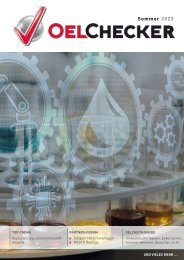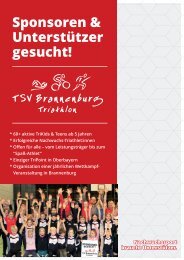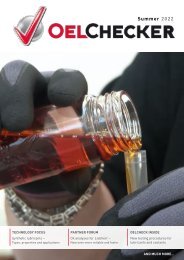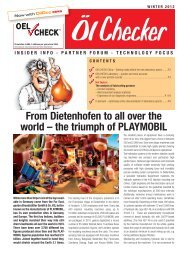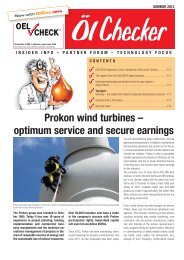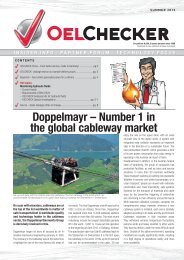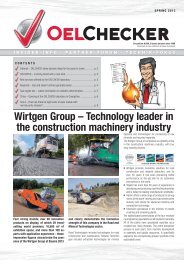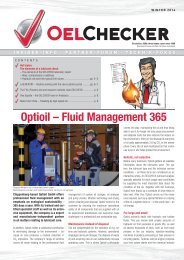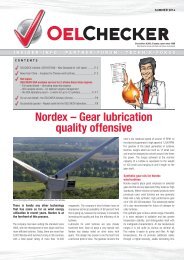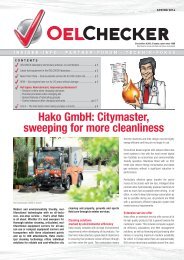OELCHECKER - Spring 2012
> Putzmeister - offering quality worldwide > Analysis kits and gas-tight sample bottles for refrigeration compressor oils > More playtime fun - thanks to OELCHECK! > 2012 customer survey results > The viscosity robot - the new OELCHECK laboratory assistant > Underground maintenance - K+S KALI GmbH workshops > Electrostatic discharges in hydraulic oils and lubricants > Question time: Could lengthy storage times have an influence on your oil samples? > and much more...
> Putzmeister - offering quality worldwide
> Analysis kits and gas-tight sample bottles for refrigeration compressor oils
> More playtime fun - thanks to OELCHECK!
> 2012 customer survey results
> The viscosity robot - the new OELCHECK laboratory assistant
> Underground maintenance - K+S KALI GmbH workshops
> Electrostatic discharges in hydraulic oils and lubricants
> Question time: Could lengthy storage times have an influence on your oil samples?
> and much more...
- No tags were found...
You also want an ePaper? Increase the reach of your titles
YUMPU automatically turns print PDFs into web optimized ePapers that Google loves.
Now with OilDoc news<br />
SPRING <strong>2012</strong><br />
Circulation: 9,000, 3 editions per year since 1998<br />
Download from www.oelcheck.de/news downloads<br />
INSIDER INFO – PARTNER FORUM – TECHNOLOGY FOCUS<br />
CONTENTS<br />
Analysis kits and gas-tight sample containers for refrigeration compressor oils ..... Pg. 3<br />
More playtime fun - thanks to OELCHECK! ........................................................... Pg. 4<br />
<strong>2012</strong> customer survey results .............................................................................. Pg. 4<br />
The viscosity robot - the new OELCHECK laboratory assistant .............................. Pg. 4<br />
Underground maintenance - K+S KALI GmbH workshops ..................................... Pg. 5<br />
Electrostatic discharges in hydraulic oils and lubricants ........................................ Pg. 6<br />
Question time: Could lengthy storage times have an influence<br />
on your oil samples? ........................................................................................... Pg. 8<br />
Putzmeister - offering quality worldwide<br />
pumping, truck-mounted concrete pumps, stationary<br />
concrete pumps, booms and accessories, industrial<br />
technology, pipe delivery of industrial solids,<br />
concrete placement and removal of excavated material<br />
in tunnels and underground, robot and materials<br />
handling technology, mortar machines, plastering<br />
machines, screed conveying, injection and external<br />
cleaning of aircraft. The installations are used in the<br />
construction industry, for mining and tunnelling in<br />
large-scale industrial projects, in the precast industry,<br />
power plants and sewage treatment plants as<br />
well as in waste incineration plants.<br />
When the nuclear power plant in Fukushima broke down, Putzmeister truck-mounted concrete pumps were used to cool<br />
it externally. Antonov wide-bodied aircraft were used to transport the world‘s largest truck-mounted concrete pumps.<br />
When the Japanese nuclear disaster in Fukushima<br />
occurred in March 2011, the whole world held its<br />
breath. External cooling was a last-ditch rescue attempt<br />
to prevent the worst-case scenario. Success<br />
was far from guaranteed but the five Putzmeister<br />
truck-mounted concrete pumps made the almost<br />
impossible possible. One thing was certain from<br />
the beginning: Putzmeister‘s special pumps were<br />
the only hope. After all, the German firm from<br />
Aichtal near Stuttgart builds the world‘s largest<br />
truck-mounted concrete pump, the M70-5, which<br />
has a boom with a vertical reach of up to 70m. Antonov<br />
wide-bodied aircraft transported the pumps<br />
to Japan. The truck-mounted concrete pumps were<br />
able to spray the cooling water exactly where it was<br />
needed over the destroyed buildings.<br />
Putzmeister products are causing a sensation time<br />
and time again when used during crisis situations,<br />
irrespective of their original intended purpose.<br />
However, day in, day out, thousands of the German<br />
manufacturer‘s machines and installations constantly<br />
prove their reliability under much less spectacular<br />
circumstances of use all around the world.<br />
Putzmeister, which was founded in 1958 by Grad.<br />
Eng. Karl Schlecht, is a company which has grown<br />
by itself, has business all around the world and is<br />
an innovative specialist machine manufacturer. At<br />
the beginning of <strong>2012</strong>, the SANY group, the market<br />
leader for concrete pumps in China, became its new<br />
owner and is continuing to build upon the German<br />
company‘s innovative prowess. Putzmeister develops<br />
and produces technically superior and serviceoriented<br />
machines in the following areas: concrete<br />
Putzmeister truck-mounted concrete<br />
pumps<br />
Truck-mounted concrete pumps have a very wide<br />
range of concrete-related uses, for example, the<br />
construction of bridges or high-rise buildings. They<br />
consist of a truck, a supporting device, a piston<br />
pump and a boom with 4 to 6 arm hinges. The<br />
hydraulic pump is powered by the truck‘s diesel<br />
engine. Thus, no external power supply is required<br />
to operate it. The machine is operated remotely, allowing<br />
the operator to move the flexible boom arm<br />
as well as control the concrete flow rate. The concrete<br />
required is fed through a truck mixer to the<br />
feed pump‘s intake chamber.<br />
The M70-5 used in Fukushima is mounted on a<br />
semitrailer, which is driven by a 500 hp tractor unit.<br />
In order to distribute the pump‘s 80-tonne weight<br />
evenly, the vehicle has 10 axles with a total length<br />
of 2.14 m. Putzmeister‘s M70-5 is the world‘s largest<br />
truck-mounted concrete pump. As if that wasn‘t
OELCHECK is gearing itself up to set up laboratories outside<br />
of Europe, starting with China! Not so long ago, this would<br />
have been unimaginable, but now we are facing up to new<br />
challenges. Soon we will be opening our first laboratory in one of<br />
Chinese industry‘s main hubs. Modern communication methods<br />
already allow our diagnosis engineers located in Germany to assess<br />
laboratory values ascertained on site in China in accordance with<br />
German engineering expertise. Specialist knowledge about limit<br />
values and warning levels will stay with us in-house as it cannot be<br />
reproduced on site.<br />
Every year, China‘s economy grows by about 10 per cent and<br />
the population level increases by around the same number of people as live in Australia. Beijing<br />
has the world‘s largest foreign exchange reserves. Lots of European machine manufacturers‘<br />
order books are full of orders from the so-called „central nation“. More and more European companies<br />
are delivering complex machines to China or setting up branches there. They understand the<br />
significance of oil analyses because they have their oil specimens analysed by OELCHECK. The need<br />
is real since there is no comparable service in China.<br />
Hence, over the last few years, we have been receiving an increasing number of oil specimens<br />
from Asia. However, couriering the specimens all the way to Brannenburg takes a long time<br />
and is expensive. So now we will be able to accommodate the needs of our clients with oil<br />
specimen analyses on site. At present, we are registering trade marks and setting up the company.<br />
At the same time we are conducting interviews with qualified employees. If everything goes to plan,<br />
the new OELCHECK laboratory in China should be up and running before the year is out! The timing<br />
could hardly have been better since, for the Chinese, <strong>2012</strong> is the year of the dragon. It should bring<br />
us good luck and will mean that we have to roll our sleeves up and tackle ambitious projects. We‘re<br />
already on it!<br />
Yours, Barbara Weismann<br />
enough, with the M42-5, Putzmeister is bringing<br />
another innovative product to the market that is setting<br />
the standard once again. The new design, from<br />
boom to chassis, has allowed the all-important<br />
overall road traffic weight to be reduced to below<br />
32 tonnes. This means that there‘s still room for<br />
things like disposable load, equipment, water and<br />
fuel. In addition, the clever relocation of the feed<br />
pipe in the boom area and the improved rigidity of<br />
the steel construction keep the distribution boom<br />
steady. Thus, even when the boom is fully extended,<br />
concrete can be poured with precision. The running<br />
costs of the M42-5 have been considerably<br />
reduced as specially designed parts were used and<br />
less fuel is required. The volume of hydraulic oil<br />
required alone has been halved to just 300 litres!<br />
From September <strong>2012</strong>, the M42-5 will be used at<br />
construction sites, including for building stadia, in<br />
the hot climes of Qatar. In preparation, extensive<br />
Putzmeister truck-mounted concrete pumps in action to construct<br />
the Frankfurt Telecommunications Tower.<br />
field tests are already under way, proving its suitability<br />
for extreme conditions. Field-test machines<br />
are fitted with an array of various online sensors<br />
that monitor the hydraulic system as well as having<br />
many other functions. Regular inspections provide<br />
information, above all, on the mechanical condition<br />
of the machines. This, together with feedback<br />
from the machine operators, is fed into the ongoing<br />
optimisation phase in order to ensure that a comprehensively<br />
tried-and-tested, and reliable product<br />
is on offer as soon as production begins.<br />
OELCHECK lubricant analyses in use<br />
since 1994<br />
Putzmeister stands for maximum quality, which<br />
unites the company and its customers. The condition<br />
of the hydraulic oil is particularly important<br />
for problem-free operation. Putzmeister has been<br />
taking advantage of OELCHECK lubricant analyses<br />
since 1994. Hydraulic oil is tested for:<br />
• On-the-job maintenance for the machines<br />
Concrete pumps can be used from as little as a<br />
few hours a month to as much as 2,000 hours<br />
a year. Reliable operational data is often not<br />
available. Therefore, Putzmeister recommends<br />
a hydraulic oil analysis after every 500 operating<br />
hours. The findings are crucial for ensuring<br />
improved oil servicing or determining if an oil<br />
change is necessary. Regular oil analyses come<br />
as standard for machines with a maintenance<br />
contract. In such cases, oil specimens are sent<br />
by the Putzmeister branch or the assembler on<br />
site. Putzmeister also recommends immediate<br />
extensive laboratory testing if the hydraulic system<br />
stops functioning properly or the oil looks<br />
strange.<br />
• Internal process safety<br />
For clean oil testing of the oil used in production,<br />
oil analyses are carried out as part of the<br />
process audit. Product stability and cleanliness<br />
of the hydraulic oils are also checked. Thanks<br />
to the checks carried out during the production<br />
process, the oil quality specified upon delivery of<br />
the machine can be guaranteed.<br />
In the OELCHECK laboratory the main characteristics<br />
of the hydraulic oil, such as viscosity, additivation<br />
and wear protection, are carefully tested in<br />
each case. The cleanliness of the hydraulic oil also<br />
plays an extremely important role. It is essential for<br />
a trouble and wear-free operation of the installations.<br />
In general, approximately 80% of hydraulic<br />
system failures are caused by impurities in the<br />
hydraulic oil. Therefore, by counting the particles,<br />
OELCHECK carefully examines hydraulic oil cleanliness<br />
(also see „Determining cleanliness categories“,<br />
ÖlChecker Winter 2004, pg. 10 et seq. It is available<br />
in the Download section at www.oelcheck.de).<br />
Hydraulic oil as a decisive structural<br />
component<br />
Putzmeister sees the hydraulic oil used in a pump<br />
as an important structural component, which is<br />
a decisive factor for performance and functional<br />
safety. Therefore, it‘s not just oil manufacturers‘<br />
product specifications that are compared. Only<br />
hydraulic oils that have been proven to meet the<br />
company‘s high quality requirements are approved<br />
for use in Putzmeister machines. As a general rule,<br />
HLP hydraulic oils, whose performance often far<br />
exceeds the minimum requirements of DIN 51524-<br />
T2, are used Putzmeister will decide which viscosity<br />
category to apply for each case (HLP 22, 32,<br />
46 or 68) on the basis of the respective climatic<br />
conditions and other operational conditions. The<br />
oil levels in the machines vary from < 100 litres to<br />
> 1,000 litres. In the new M42-5, the newly developed<br />
hydraulic system meant that the oil volume<br />
could be reduced to approx. 300 litres. Putzmeister<br />
was able to take this even further. Thanks to the<br />
considerably lower oil levels, operating costs fall<br />
and, after an oil change, less waste oil is released<br />
into the environment. However, since the volume<br />
of hydraulic oil is considerably lower, the demands<br />
made on it are that much greater. However, if only<br />
Putzmeister-approved oils are used and regular<br />
OELCHECK lubricant analyses are carried out,<br />
these oils will rise to any challenge.
OELCHECK INSIDER INFO<br />
Optimised analysis kits and gas-tight<br />
sample containers for refrigeration compressor oils<br />
Our test procedures selected for analysing oils from refrigeration compressors have<br />
proven themselves time and time again over the years. However, we have further<br />
optmised the tests, our laboratory equipment and the sample containers for these<br />
products yet again. It‘s not just the users of modern synthetic refrigeration machine<br />
oils who are benefiting!<br />
New analysis kits VK1 and VK2 for refrigeration compressor oils identify:<br />
• Wear metals: iron, chrome, tin, aluminium, nickel, copper, lead and molybdenum<br />
• Additives: calcium, magnesium, zinc, phosphorus, barium, boron and sulphur<br />
• Contaminants: silicon, potassium, sodium and lithium<br />
• PQ index<br />
◦ Oxidation<br />
• Optical check (colour change, visible particles)<br />
◦ Special outgassing process<br />
• Viscosity at 40°C and 100°C as well as the viscosity index ◦ Water content according to<br />
Karl Fischer<br />
In addition to the tests above for analysis kit VK 2:<br />
Neutralisation Number (NN) or Acid Number (AN) or Base Number (BN)<br />
Refrigeration compressor oils should lubricate, minimise<br />
friction, protect from wear and corrosion, cool,<br />
clean, prevent deposits and create a seal or reduce<br />
any leakage flow in the compression chamber. However,<br />
for the most part they also come into direct<br />
contact with the refrigerating agent. A refrigeration<br />
machine oil therefore has to work in harmony<br />
with it as much as possible. Impurities from seal<br />
materials or negative impacts from moisture or even<br />
water are one of the criteria for an oil change or<br />
additional oil servicing measures. The temperatures<br />
during compression of the gaseous refrigerating<br />
agent of up to 120°C can significantly accelerate<br />
oil oxidation, hence its ageing. During an oxidation<br />
process, mostly acids form in the oil which can have<br />
a corrosive effect on the compressor components,<br />
particularly if there is any residual moisture.<br />
The production capacity of the refrigeration compressor<br />
oil and its interaction with the refrigerating<br />
agent have decisive effects on the service life of the<br />
compressor. Therefore, regular lubricant analyses<br />
are vital. They provide information on the condition<br />
of the oil and the complex chemical reactions that<br />
have taken place in the compressor oil. If necessary,<br />
any potential damage and disruptions to operations<br />
can be counteracted.<br />
There are special OELCHECK analysis kits for the<br />
extremely important task of monitoring refrigeration<br />
compressor oils. When the test processes in the kits<br />
were compiled, not only were our experience and<br />
the recommendations of previous compressor and<br />
oil manufacturers taken into consideration, but also<br />
the specifications of work group E-DIN 51503-2.<br />
NEW<br />
Acids or bases in refrigeration machine<br />
oils<br />
The Neutralisation Number (Acid Number or AN)<br />
provides information on the level of mineral acids as<br />
well as water-soluble and insoluble organic acids in<br />
a refrigeration compressor oil. Mineral acids, such<br />
as hydrochloric or hydrofluoric acid, are formed<br />
through the decomposition of halogen refrigerating<br />
agents or upon interaction with the refrigeration machine<br />
oil. Organic acids result from the oxidation of<br />
refrigeration machine oils and the decomposition of<br />
ester oils. All of these acids lead to the corrosion of<br />
the metallic materials in refrigeration systems, promote<br />
oil ageing and cause unfavourable changes in<br />
the electrical isolation values of motor compressors.<br />
The Base Number (BN) provides information on<br />
the level of alkaline substances in the oil. They<br />
are caused by oxidation in ammonia refrigeration<br />
systems in the case of thermal loading. Inside the<br />
compressor they lead to oil silting and on the hot<br />
side, in pressure chambers<br />
and on valves, to<br />
carbonaceous deposits.<br />
Top tip: If you want to learn more about<br />
refrigeration machines and their oils, read the<br />
article „OELCHECK analyses keep refrigeration<br />
machines fit“ in ÖlChecker Summer 2008 at<br />
www.oelcheck.de.<br />
New sample containers<br />
With pre-paid kits VK1 and VK2 for oils from refrigeration<br />
compressors, from now on, customers<br />
are provided with newly designed gas-tight 100 ml<br />
sample containers made from shatter-proof glass<br />
with a metal lid. They are suitable for all oil types<br />
and refrigerating agents. In addition, they can withstand<br />
the internal pressure, which can build up due<br />
to residual refrigerating agent in the sample. The<br />
sample amount is extracted via the oil outlet provided<br />
by the manufacturer in the compressor circuit.<br />
If the sample foams quite heavily, some of the gas<br />
can be released from the refrigerating agent prior<br />
to sealing. Gas should not be released if a synthetic<br />
compressor oil is used and/or ammonia is used as<br />
a refrigerating agent. The container must be carefully<br />
sealed immediately since these substances are<br />
extremely hygroscopic and can soak up moisture<br />
from the air even if the contact with the atmosphere<br />
is short.<br />
Extensive sample preparation<br />
The individual process steps were redesigned for<br />
refrigeration machine oils. A partial quantity of max.<br />
5 g is directly extracted when the sample container<br />
is first opened. That way, the exact water content<br />
can be ascertained according to the Karl Fischer<br />
method. To ascertain the other values, the proportions<br />
of refrigerating agents in the sample must<br />
be removed. The opened sample containers are<br />
therefore clamped in a gas-tight appliance. After<br />
the samples are warmed to 80°C, inert gas flows<br />
through the oil until no more refrigerating agent<br />
can be found in the waste air flow. Only after this<br />
process, which lasts for more than an hour, has<br />
been completed, is the sample ready for further<br />
extensive laboratory tests.<br />
Our technical team can advise you on the right analysis kit for you:<br />
+49(0)8034-9047-210, tsek@oelcheck.de.<br />
Measuring the Neutralisation Number for refrigerating machine oils in the<br />
OELCHECK laboratory
OELCHECK INSIDER INFO<br />
More playtime fun - thanks to OELCHECK!<br />
The fun has really begun at the big playground<br />
in the municipality of Brannenburg.<br />
Just in time for the start of the good weather,<br />
on 20 April a fantastic set of climbing ropes<br />
was opened, funded by our 2011 Christmas<br />
donation.<br />
In line with the motto „making children happy<br />
instead of giving Christmas presents“, we stopped<br />
giving our customers Christmas presents a few<br />
years ago. Instead of giving them Christmas<br />
presents we make donations. In 2011, this amounted<br />
to 12,000 euros for a project for children in<br />
our municipality.<br />
The climbing ropes are used in particular by children<br />
from the special-needs school and the day nursery.<br />
Lots of children can swing, rock and balance on the<br />
ropes at the same time as each other or compete to<br />
throw each other off balance. Three angled, hinged<br />
poles are connected to each other by ropes at the<br />
top and are balanced with long guy wires. Each of<br />
the horizontal balance beams is hung in the middle<br />
of the poles‘ connecting ropes in such a way that<br />
they affect each other‘s movements. At first glance,<br />
the construction seems straightforward, but it has<br />
been cleverly thought out.<br />
The children could hardly wait. Mayor Mathias Lederer<br />
(on the right-hand side in the picture) hadn‘t even<br />
finished giving his speech when the children started to<br />
tackle the rope construction donated by OELCHECK.<br />
<strong>2012</strong> customer survey results – 96% of participants would<br />
recommend OELCHECK<br />
A great big „thank you“ to all those who took part<br />
in our <strong>2012</strong> customer survey! Out of 14,469 customers,<br />
1,749 took part in the online questionnaire.<br />
That‘s an exceptionally good return rate of 12%.<br />
Participants from almost all of our fields of business<br />
took the time to answer our various questions.<br />
The evaluation of the questionnaires also showed<br />
very clearly how highly users rate our lubricant<br />
analyses and how interested they are in the potential<br />
findings. Our range of analysis services and<br />
additional services, our expertise, speed and customer<br />
service were all measured along with a whole<br />
host of other factors.<br />
The results of the questions on customer satisfaction<br />
were as follows:<br />
• 96% of respondents rated their satisfaction with<br />
our services as either „very good“ or „good“.<br />
• 87% of customers were happy with our prices.<br />
• Our processing speed was rated as either „very<br />
good“ or „good“ by 95% of respondents.<br />
• 84% were either „very satisfied“ or „satisfied“<br />
with the quality of our customer advice.<br />
• 87% rated our employees‘ willingness to help/<br />
politeness as either „very good“ or „good“.<br />
We were also very pleased with the many additional<br />
comments and suggestions. We will look into them<br />
in detail and comment on the most popular suggestions<br />
in the next edition of ÖlChecker. A very<br />
important topic, however, is our web portal www.<br />
laborberichte.com. 42% of respondents had not<br />
actually heard of it. We need to do a lot more work<br />
to promote it. After all, it can offer huge benefits<br />
for users. Customers who actively use it to manage<br />
their laboratory reports and data say that they<br />
don‘t know how they managed without it. Just like<br />
visitors to our homepage, who find the extensive<br />
information on there extremely useful. The „Knowledge<br />
from A-Z“ section alone is fast becoming a<br />
standard reference for lubricants and oil analytics.<br />
The viscosity robot - the new OELCHECK laboratory assistant<br />
Viscosity is the single most important physical<br />
characteristic of an oil or a hydraulic fluid. It describes<br />
the oil‘s flow qualities and is responsible for<br />
its ability to protect surfaces against wear by building<br />
a hydrodynamic lubricating film. Determining<br />
viscosity at 40°C and 100°C is an integral part of<br />
the scope of analysis for every OELCHECK analysis<br />
kit. Since viscosity changes according to temperature,<br />
it is measured twice.<br />
But now our new robot is taking matters into its<br />
own hands. It receives 20 samples on tray. It skilfully<br />
introduces each 2 mm pipette into the oil<br />
and extracts the prescribed amount and checks<br />
four samples at the same time. It does everything<br />
consistently, quickly and precisely. The sample<br />
amounts are exactly right - „measurement error“ is<br />
not in the vocabulary of our new „colleague“.<br />
Of all the many tests carried out every day at our<br />
laboratory, viscosity measurements take up a very<br />
large proportion of our time. The required amounts<br />
of oil must be extracted from each container using<br />
a pipette for the two viscosity measurements. It‘s<br />
monotonous work but work which requires a lot of<br />
concentration on the part of laboratory assistants.<br />
Top tip: If you want to learn more about<br />
viscosity and viscosity temperature behaviour,<br />
read about it all in ÖlChecker <strong>Spring</strong> 2007 at<br />
www.oelcheck.de.<br />
The new viscosity robot at work
OELCHECK PARTNER FORUM<br />
The K+S KALI GmbH maintenance engineers<br />
for the Hattorf/Wintershall mine<br />
use the pithead cage to get down to their<br />
enormous underground workshop. Their<br />
‚office‘ is 750 m under the Earth‘s surface.<br />
125 employees maintain and service the<br />
more than 1,000 machines currently in<br />
use in the mine. They operate round the<br />
clock using a three-shift system.<br />
K+S KALI GmbH is one of the world‘s leading<br />
potash mining companies. They specialise in the<br />
extraction and preparation of heterogeneous crude<br />
salts, particularly those containing magnesium.<br />
They are efficient and environmentally aware, and<br />
use a unique technology. As a supplier of speciality<br />
and standard fertilizers and products for industrial<br />
application, the company operates in all areas of<br />
life. The crude salts extracted underground, which<br />
all originate from the crystallisation of salty seawater,<br />
have different compositions depending on the<br />
deposits. Potash is mined in the Hattorf/Wintershall<br />
(HW) mine. Potassium, chemical symbol „K“,<br />
denotes, amongst other things, potassium-containing<br />
fertilizers for application in agriculture.<br />
The salt cannot be produced by synthetic means.<br />
As a fertilizer, it is essential for productive and<br />
healthy plant growth. Therefore, potassium fertilizers<br />
significantly help contribute to improving food<br />
supplies, both from a quantitative and qualitative<br />
perspective, for the world‘s growing population. In<br />
addition, diverse precursors for the production of<br />
industrial and pharmaceutical products originate<br />
from potassium.<br />
In order to extract the valuable raw material in the<br />
HW mine, holes up to 7 metres deep are dug in the<br />
relatively soft rock using special large-hole drilling<br />
Underground maintenance<br />
In the 20,000 m² workshop, the devices are serviced and repaired underground.<br />
K+S KALI GmbH workshops<br />
carriages. Due to blasting, the rock can loosen into<br />
the cavities produced as a result of the relatively<br />
thick drills. Large loaders transport the loosened<br />
rock to heavy crushers. They reduce the rock in<br />
size to fist-size pieces. These are then transported<br />
over kilometre-long belt conveyors to the shaft.<br />
Above ground, the rock is then further processed<br />
into high-quality fertilizers and industrial products.<br />
As with coal mining,<br />
an extensive<br />
ventilation system<br />
ensures a supply<br />
of fresh air to the<br />
mine. Used air and<br />
machine exhaust<br />
fumes are diverted<br />
via return air tunnels,<br />
which cannot<br />
be driven down. In<br />
the workshop, it is<br />
a pleasant 20°C<br />
to 28°C all year<br />
round. However,<br />
the air contains lots<br />
of fine salt particles. So corrosion and rust do not<br />
occur in the potash mine. The air is very dry and the<br />
metals do not corrode without water or moisture.<br />
However, things are very different if one of the devices<br />
has to go to the surface. Due to condensation,<br />
which develops on the relatively warm machine, it<br />
is immediately at risk on account of the accrued<br />
salt dust. This is one of the reasons why all maintenance<br />
and repair work is carried out underground<br />
where possible. What‘s more, relocating the vehicles<br />
is extremely time-consuming. They are carried<br />
through a transport shaft with a special goods lift.<br />
However, the lift can only take 20 tonnes at a time.<br />
Therefore, particularly large machines must be disassembled<br />
ready for transport beforehand.<br />
The workshop in the HW mine is enormous. The<br />
workspace and parking areas extend over an<br />
overall length of 480 m with a width of 25 m. The<br />
workshop‘s equipment is also impressive. Supported<br />
by a SAP system, the maintenance experts<br />
are responsible for servicing the 1,154 machines<br />
currently in operation. Whether loaders, large-hole<br />
drills, blast-hole drills or forklift trucks, they all need<br />
to be inspected in the workshop in accordance with<br />
strict specifications and, if necessary, repaired. On<br />
average, an assessment is required from the maintenance<br />
experts after every 300 hours of operation.<br />
OELCHECK lubricant analyses are part of their daily<br />
toolkit. The hydraulic oil of the large loaders is<br />
tested after every 500 hours of operation.<br />
The crude salt, loosened by blasting, is transported to the crushers<br />
using wheel loaders. K+S KALI GmbH produces 8 million tonnes of<br />
potash fertilizer in Germany per annum.<br />
Underground, only latest-generation, largecapacity<br />
loaders are used. Their hydraulic system<br />
works with approx. 700 litres of HLP hydraulic oil.<br />
The oil is changed depending on its condition and<br />
only then if the OELCHECK laboratory deems it<br />
necessary. As part of analysis kit 2, designed for<br />
oils from mobile hydraulics, wear metals (Fe, Cr,<br />
Cu, Pb, Al, Ni, Sn), additives (Ca, P, Zn, S) and any<br />
salt-containing impurities (K, Mg, Na) are identified.<br />
Particles are counted in seven size categories in accordance<br />
with ISO 4406 and SAE 4059. The general<br />
condition of the oil is assessed in terms of its<br />
viscosity at 40°C und 100°C, the viscosity index, IR<br />
oxidation, additive decomposition and appearance.<br />
The diagnosis engineers not only offer advice on oil<br />
change extensions but also suggest measures for<br />
improved servicing.<br />
As well as for guidance on condition-dependant oil<br />
changes, OELCHECK analyses are also used if the<br />
cause of damage to a device needs to be ascertained.<br />
Oil analytics have also proved invaluable in<br />
precautionary screening tests of the gears in the<br />
axles of all underground machines. Although the<br />
hypoid gear oil should still usually have wear protection<br />
reserves after a service life of 600 operating<br />
hours, it had already reached its limit in some<br />
cases. An immediate oil change, which was diagnosed<br />
for some gears, may have prevented more<br />
expensive damage. The maintenance engineers in<br />
the underground workshop have acquired invaluable<br />
knowledge about the work that they do thanks<br />
to the screening tests and OELCHECK lubricant<br />
analyses have once again proven their worth.
Electrostatic discharges in<br />
hydraulic oils and lubricants<br />
OELCHECK conductivity checks increase safety<br />
Lubricants are normally only slightly conductive and therefore sometimes also work as insulators. On the other hand, under certain<br />
circumstances, oils are capable of conducting an electric current. In practice, the electric conductivity of turbine and hydraulic<br />
oils is becoming increasingly important. They are normally only slightly conductive and under appropriate conditions are prone<br />
to becoming electrostatically charged. If there are subsequent discharges, the oil and the system can be damaged. Therefore, to<br />
guarantee maximum safety, in the future OELCHECK will be offering to measure conductivity at different temperatures as a supplementary<br />
individual test.<br />
Electric conductivity is a measure of the electrostatic<br />
chargeability of liquids. Usually it is expressed<br />
as a pS/m (picosiemens/metre = 10 -12 ohm) unit.<br />
As well as on the type of liquid, conductivity also<br />
depends on the concentration of movable charge<br />
carriers. Pure distilled water, for example, is only<br />
slightly conductive. However, if the water contains<br />
„impurities“ such as salts, acids or bases, then its<br />
conductivity increases.<br />
Table 1: API base oil groups<br />
Group I – lightly refined base oils (SN or Solvent Neutral)<br />
Oils with an increased proportion of aromatics, less than 90% saturates.<br />
The VI is between 80 and 120. Additives dissolve relatively easily.<br />
Base for: simple gear and hydraulic oils.<br />
Conductivity: high polarity, best conductivity of over 2,000 pS/m. Values smaller than 2,000<br />
aeroplane<br />
SAE 10W 40 >2,000 Aeroplane hydr. synth 29<br />
Manual transmission gear oil >2,000 Synthetic 9<br />
Paper machine oil (Zn-P) 350 Aircraft PAO 70<br />
Paper machine oil (S-P) 10<br />
Silicate ester (refrigeration) 1,500 Insulating liquids 12
OELCHECK TECHNOLOGY FOCUS<br />
Furthermore, at a constant temperature, conductivity<br />
still changes during operation due to additive<br />
reactions, wear metals, reactions with metal<br />
surfaces, water and the formation of ageing and<br />
oxidation products.<br />
Optimisation approaches for the prevention of electrostatic problems<br />
• Installation of special stat-free filters instead of conventional filter cartridges. Such filters can<br />
discharge the charge or even prevent it from occurring.<br />
• Using an oil with a different make-up and poorer conductivity value can have a remedial effect.<br />
• Choose or amend the selection of material combinations in the system so that, despite electrostatic<br />
charge, the formation of microsparks is prevented.<br />
• Optimise flow diameter, tank hold times or tank volumes. As a result, the charge potential can<br />
also be minimised.<br />
Conductivity in pS/m<br />
200<br />
Discharges (ESD) and possible<br />
180<br />
160<br />
140<br />
120<br />
100<br />
80<br />
60<br />
40<br />
20<br />
0<br />
20 25 30 35 40<br />
Temperature in °C<br />
Conductivity of a zinc-free hydraulic oil during temperature<br />
change<br />
The electrostatic charge of oils<br />
Although monitoring conductivity has so far been<br />
unable to achieve any great success in the area of<br />
sensor technology, the parameter is gaining significance<br />
with regard to electrostatic charges and<br />
discharges in lubricant and hydraulic systems.<br />
In oil circulating systems, in general, there can<br />
be electrostatic charges if there is friction in the<br />
flow between the oil and the surfaces surrounding<br />
it. The strength of the static charge depends on<br />
many different and partly interconnected factors.<br />
The energy density, which builds up in the system<br />
and then leads to subsequent discharges, depends<br />
on the oil‘s conductivity and the volume flow. The<br />
more oil flows that through a circulation pipe per<br />
cm² cross-sectional area and the lower the oil‘s<br />
conductivity, the greater the potential for an electrostatic<br />
charge.<br />
Oil can be especially electrostatically charged if:<br />
• The oil is formulated with a base oil from<br />
Group II or III;<br />
• The oil contains no polarising, e.g. zinc-containing,<br />
additives;<br />
• The conductivity of the new or old oil is less than<br />
400 pS/m;<br />
• The oil is fed into pipes which are too small;<br />
• The oil is moved with too high a flow velocity;<br />
• The oil produces friction in poorly designed filter<br />
elements;<br />
• Pipes and hoses are not earthed;<br />
• The oil level has become too low;<br />
• The oil contains high proportions of undissolved<br />
air (air bubbles).<br />
consequences<br />
If the level of electric charge in the system becomes<br />
too great, there will be electrostatic discharge<br />
(ESD). In such cases, micosparks occur<br />
or sparking. Often you can also hear a crackling<br />
or clicking sound near the filter or in the tank. In<br />
the case of high charges, this discharge could be<br />
repeated several times, in quick succession. Locations<br />
at which the discharge primarily occurs are, in<br />
particular, areas with vastly different material combinations.<br />
Modern filters with a high proportion of<br />
plastic are often affected. The microsparks caused<br />
by the static charge lead to temperatures of some<br />
1,000°C. In the case of even slightly flammable<br />
liquids, this can be extremely dangerous. Also, if<br />
hydrocarbon vapours have formed in the tank ventilation<br />
area, a system could spontaneously combust.<br />
However, if the discharge sparks occur within<br />
the circulation system of turbine or hydraulic oils,<br />
they are normally smothered very quickly by the oil.<br />
Nevertheless, these mini explosions can can burn<br />
holes in the filters or even seriously impair the oil<br />
due to the increased build-up of oil sludge.<br />
Turbine and hydraulic oils are<br />
particularly affected<br />
Electrostatic charges and discharges have been<br />
occurring more often in recent years in systems<br />
with turbine and hydraulic oils. Several developments<br />
are responsible for this.<br />
• Modern hydraulic fluids and turbine oils have<br />
become increasingly less conductive because<br />
of the global trend to use modern base oils and<br />
additives. Turbine oils used to be based on relatively<br />
conductive, lightly refined base oils from<br />
Group I. Since then, in particular for gas turbine<br />
oils, more oxidation-resistant, better refined<br />
base oils from Group II or even partly synthetic<br />
base oils from Group III are being used. Such<br />
oils are considerably less conductive. In addition,<br />
turbine oils normally contain hardly any metalorganic<br />
additives. As such, that should prevent the<br />
formation of unwanted deposits (varnish).<br />
• Since new systems enjoy a more compact design,<br />
the tank capacity is considerably smaller<br />
and the displaced volume is proportionally larger.<br />
• At the same time, requirements for oil purity are<br />
increasing. This, in turn, leads to a higher filtration<br />
rate.<br />
• The intensity of the filtration and the electrostatic<br />
charge properties of the oil (resulting from the<br />
filtration) increase.<br />
• Due to the low conductivity of these oils, often far<br />
below 1,000 pS/m, in unfavourable conditions,<br />
the tendency for electrostatic charging increases.<br />
Measure conductivity and prevent<br />
damage<br />
In order to be able to prevent any damage from<br />
electrostatic discharges, it is not only the tivity of fresh oils that needs to be known. For old lu-<br />
conducbricants,<br />
in the case of up quantities of over 1,000<br />
litres, the parameter is also<br />
fillparticularly<br />
important if<br />
nothing is known about the<br />
used oil or a burning smell or<br />
soot particles are noticeable.<br />
Therefore, OELCHECK is now<br />
offering conductivity measurements<br />
at different peratures as an additional<br />
test. The process has been<br />
tested over several years<br />
tem-<br />
and is conducted in line with<br />
ASTM D2624. Originally it<br />
was developed for inspecting<br />
aeroplane kerosene in order to avoid accidents due<br />
to charging in jet fuel.<br />
The oil‘s conductivity value is measured in pS/m.<br />
If conductivity at 20°C is more than 400 pS/m,<br />
there is hardly any risk of any damage to the oil<br />
or the system from electrostatic charges. However,<br />
if the value is lower, there is a very real possibility<br />
that the phenomenon could occur. If an oil with an<br />
increased ESD risk is being used, earthing the entire<br />
system is not a credible countermeasure. The<br />
voltage inside the system cannot be discharged<br />
through an earth wire. However, there are several<br />
other optimisation approaches for active prevention.
SPRING <strong>2012</strong><br />
IMPRINT<br />
When our gears were last inspected,<br />
about three months ago, as always, we<br />
took oil samples. Unfortunately, however,<br />
we forgot to send them straight to<br />
OELCHECK. Will the analysis results still<br />
be representative if we send the samples<br />
off for analysis today? Can values,<br />
which provide meaningful information<br />
on the condition of the gears and lubricants,<br />
change if the oil samples are<br />
stored for a long period of time?<br />
OELCHECK:<br />
In principle, we can also examine oil samples that<br />
were taken a long time ago. Storing oil samples for<br />
a long period of time doesn‘t significantly affect<br />
analysis data. However, the analysis values will<br />
only reflect the conditions at the time when the<br />
sample was taken. Only you can decide whether<br />
this „obsolete“ information, which only partially<br />
describes the real condition of the lubricant used<br />
and the gears, is still useful. The oil and the elements<br />
that it contains are constantly changing. A<br />
sample only provides information about a particular<br />
moment in time.<br />
Prompt tests provide representative<br />
results<br />
Wear metals, impurities, oil additives and the condition<br />
of the oil don‘t change when stored in the<br />
original OELCHECK sample container at normal<br />
ambient temperature. However, the more time that<br />
elapses from the point that the sample is taken to<br />
the point where the test is carried out, the more<br />
significantly the condition of the sample can deviate<br />
from the condition of the lubricant currently<br />
being used. Therefore, samples should always be<br />
sent to our laboratory as quickly as possible. If,<br />
however, you forget to send them, an experienced<br />
diagnosis engineer can estimate which values will<br />
have changed in the meantime in current operations,<br />
if previous trend analyses are available.<br />
In the case of a gear with oil change intervals of<br />
more than 40,000 operating hours and 6-monthly<br />
oil samples, one or two days won‘t make a difference.<br />
However, in the case of a biogas engine that<br />
operates around the clock and whose oil must be<br />
changed after less than 600 operating hours (25<br />
days), forgetting to send an oil sample could cause<br />
QUESTION TIME<br />
an engine failure. Therefore, make sure that samples<br />
reach the OELCHECK laboratory no later than<br />
a week after they have been taken. If a sample<br />
has been lying around for several weeks or even<br />
months we would not recommend sending it for<br />
testing. The information that it contains would no<br />
longer reflect current operations.<br />
Only if a sample is examined promptly can you<br />
benefit from the invaluable advantages of our lubricant<br />
analyses, carry out oil changes based on<br />
the condition of the oil and detect possible damage<br />
in advance.<br />
Quick, clean and reliable - the OELCHECK despatch department combines your<br />
individual analysis kit orders for you.<br />
Special OELCHECK sample containers<br />
for all lubricants<br />
So that you receive meaningful results based on<br />
the oil samples that you send in, follow our guidelines<br />
on how to take samples. You will find them<br />
under „Take & send samples“ on www.oelcheck.<br />
de. Please only use the pre-paid OELCHECK sample<br />
containers, which were specially developed<br />
for lubricant samples. They comprise the relevant<br />
full scope of the test and a meaningful diagnosis,<br />
depending on the colour of the lid.<br />
The empty containers and their lids are packaged<br />
individually. That way, we can ensure that the<br />
containers remain as pure as possible. Contamination<br />
of samples, for example with dust particles<br />
or moisture, is impossible if the packaging is not<br />
opened until on site. However, not even our sturdy<br />
sample container made from PET can fully protect<br />
the lubricant sample from environmental influences<br />
forever. If you leave a sample in the sunlight<br />
for a long time, the colour of the oil could change.<br />
Antioxidants in turbine oils can make the oil look<br />
ÖlChecker – a magazine from OELCHECK GmbH<br />
Kerschelweg 28 · 83098 Brannenburg · Germany<br />
info@oelcheck.de · www.oelcheck.de<br />
All rights reserved. Reproduction without permission prohibited.<br />
Concept and text: Astrid Hackländer, Marketing & PR,<br />
A-4600 Thalheim<br />
www.astridhacklaender.com<br />
Layout and design: Agentur Segel Setzen, Petra Bots,<br />
www.segel-setzen.com<br />
Photos: OELCHECK GmbH · OilDoc GmbH · Putzmeister GmbH ·<br />
K+S KALI GmbH<br />
violet after a few days and light hydraulic oils turn<br />
darker under the effects of light. However, with the<br />
exception of the colour, the typical characteristics<br />
ascertained don‘t change. If the oil sample is exposed<br />
to greater fluctuations in temperature, the<br />
water content of some oil types can also change<br />
during storage time.<br />
Our specially designed PET sample containers are<br />
clean and temperature-stable, can be sealed firmly<br />
and have proven themselves on millions of occasions.<br />
However, even they‘re not suitable for every<br />
type of lubricant. Refrigeration compressor oils, for<br />
example, almost always contain residual gaseous<br />
refrigerating agents. For<br />
these, we offer gas-tight<br />
sample containers made<br />
from shatter-proof glass<br />
with a metal cover (see<br />
pg. 3 of this edition). They<br />
can withstand the pressure<br />
of the gaseous refrigerating<br />
agents and ensure<br />
that even tricky samples<br />
make it to the OELCHECK<br />
laboratory safely. Also for<br />
transformer and insulating<br />
oils, special gas-tight glass<br />
syringes and aluminium containers (see ÖlChecker<br />
Winter 2011) are integral parts of the relevant<br />
analysis kit.<br />
Conclusion: Avoid storing samples for<br />
any unnecessary length of time<br />
Always send lubricant samples to our laboratory<br />
as quickly as possible! They are tested and assessed<br />
by the end of the following working day if<br />
they reach us by 12.00 p.m.<br />
The analysis values that we measure will not<br />
change drastically in storage. However, if several<br />
days or weeks elapse between the point when the<br />
sample was taken and the time when it is tested,<br />
the analysis values could deviate from the current<br />
condition of the lubricant still being used.<br />
By sending your samples in good time, you are<br />
actively helping to ensure that you benefit as<br />
much as possible from the OELCHECK laboratory‘s<br />
speed and the unbeatable advantages of<br />
OELCHECK lubricant analyses.<br />
OELCHECK will also answer your questions on tribology and lubricant analyses.<br />
Send us your questions by e-mail (info@oelcheck.de) or by fax (+49 8034/9047-47).
s ++ news ++ news ++ news ++ news ++ news ++ news ++ news ++ news ++ news ++ new<br />
The countdown has begun!<br />
The next OilDoc Conference and Exhibition will<br />
take place in Rosenheim (near Munich) from 22 to<br />
24 January 2013. Preparations for the event are<br />
already under way. As expected, our call for papers<br />
has been met with a great response. However, we<br />
were very surprised by the large number of new<br />
topics. Whether it‘s ideas from the world of tribology,<br />
the latest lubricant development trends or, in<br />
particular, successful concepts and practical examples<br />
from the areas of fluid management and<br />
maintenance, the topics and abstracts that have<br />
been submitted all look extremely promising.<br />
An ambitious programme<br />
The programme committee have really got their<br />
work cut out now. The topic suggestions that have<br />
been submitted are all top-notch and, given the<br />
quality, making a selection will be no mean feat.<br />
Led by Peter Weismann and Rüdiger Krethe, the<br />
committee are still compiling the ambitious programme<br />
and it‘s already May <strong>2012</strong>.<br />
The members of the programme committee<br />
are:<br />
Jo Ameye, Executive Vice President - Global<br />
Sales, Fluitec International, Belgium<br />
Josef Barreto-Pohlen, Business Development<br />
for Tribology, TUNAP Industrie Chemie<br />
GmbH & Co. Produktions KG, Germany<br />
Prof. Dr. Eng. Wilfried J. Bartz, Technical<br />
Academy of Esslingen, Germany<br />
Dr. Karin Baumann, Technical Manager<br />
Competence Center Lubes, OMV Refining &<br />
Marketing GmbH, Austria<br />
Dr. Günther Bodesheim, Head of Tribology<br />
& Chemistry, Klüber Lubrication München KG,<br />
Germany<br />
Grad. Eng. Jürgen Deckert, Head of<br />
Research & Development, Addinol Lube Oil<br />
GmbH, Germany<br />
Univ. Prof. Dr. Eng. Ludger Deters,<br />
Chair of Machine Elements and Tribology,<br />
Otto-von-Guericke University Magdeburg,<br />
Germany<br />
Ph.D (Sciences) Gerd Dornhöfer, Chief<br />
Expert Lubrication Technology, Robert<br />
Bosch GmbH, Germany<br />
Dr. Eng. Gerhard Gajewski, Quality -<br />
Product Safety & Lubricant Management,<br />
SIEMENS AG, Germany<br />
Dr. Robert M. Gresham, Director of<br />
Professional Development, STLE Society<br />
of Tribologists and Lubrication Engineers,<br />
USA<br />
Richard Karbacher, Schaeffler Technologies<br />
AG & Co. KG, Germany<br />
Stuart Lunt, Research Manager, Kittiwake<br />
Developments Ltd., UK<br />
Jesús Terradillos, TEKNIKER Technological<br />
Centre, Spain<br />
MSc. Eng. Wojciech Majka, President of<br />
the Board, CEO ECOL Sp. z o.o., Poland<br />
Dr. Arthur Wetzel, Head of Lubricants and<br />
Fuels, ZF Friedrichshafen AG, Germany<br />
Dr. Eng. Mathias Woydt, German Federal<br />
Institute for Materials Research and Testing<br />
(BAM), Germany<br />
(photos, clockwise)<br />
news<br />
Highlights of the <strong>Spring</strong> <strong>2012</strong> edition:<br />
OilDoc Conference and Exhibition 2013<br />
Infrared spectroscopy in practice<br />
Certified Lubrication Specialist (CLS) certification<br />
Seminars, workshops and symposia<br />
OilDoc at the IHA conference<br />
OilDoc under way in the USA<br />
OilDoc Academy successfully certified<br />
The OilDoc executives: Rüdiger<br />
Krethe, Grad. Eng. and<br />
Peter Weismann, Grad. Eng.
ews ++ news ++ news ++ news ++ news ++ news ++ news ++ news ++ news ++ news ++<br />
Four top-class supporters<br />
The OilDoc Conference and Exhibition 2013 will soon be supported by four companies or organisations.<br />
They are:<br />
Noria Corporation, USA<br />
This company, which was originally founded as<br />
a publishing house, publishes the internationally<br />
renowned „Machinery Lubrication“ magazine. The<br />
successful publisher‘s team is made up exclusively<br />
of practitioners from the fields of maintenance and<br />
tribology. Therefore, Noria also offers a variety of<br />
system and machine lubrication services as well<br />
as oil analytics. Noria experts offer training and<br />
consultancy services and actively contribute to<br />
symposia and conferences.<br />
STLE, USA<br />
The Society of Tribologists and Lubrication Engineers<br />
(STLE) represents the interests of more than<br />
4,000 technical experts from industry, science<br />
and government in the USA, Canada and many<br />
other countries. Its members can take advantage<br />
of an extensive array of seminars and Certified<br />
Lubrication Specialist (CLS), Oil Monitoring Analyst<br />
(OMA) and Certified Metalworking Fluids Specialist<br />
(CMFS) training sessions, the „Tribology & Lubrication<br />
Technology Journal“ (TLT) and lots of technical<br />
newsletters.<br />
TAE, Germany<br />
The Technical Academy of Esslingen (TAE) has<br />
been a professional training and education partner<br />
for companies and their specialists and executives<br />
for over 50 years. TAE‘s International Colloquium<br />
on Tribology is world renowned. It is held every two<br />
years in Osterfildern, near Stuttgart. Led by Prof. Dr.<br />
Eng. Wilfried J. Bartz, the TAE will be contributing to<br />
the OilDoc Conference 2013 with an extensive session<br />
on tribology. In return, OilDoc held a session<br />
at TAE‘s 18th International Colloquium on Tribology<br />
in <strong>2012</strong>.<br />
OELCHECK GmbH, Germany<br />
The lubricant analysis laboratory offers over 50<br />
test processes and, at least in Europe, is the most<br />
modern of its kind. It tests and comments on over<br />
200,000 samples every year. As a result, its database<br />
is huge, with over 1.5 million analyses and<br />
findings. OELCHECK experts provide support for<br />
the selection of lubricants and offer expert opinions<br />
for damage clarification. In 2010, the OilDoc<br />
Academy was established as part of a spin-off<br />
from OELCHECK GmbH.<br />
Your chance to be at the OilDoc Exhibition<br />
OilDoc will once again be organising an international exhibition at the Oil-<br />
Doc Conference 2013. More than 30% of the stands have already been taken.<br />
If you want to book a place as an exhibitor, take this opportunity to secure<br />
your place at the OilDoc Conference and Exhibition. You will make invaluable<br />
contacts with international decision makers and opinion formers.<br />
Current exhibitor list & hall plan (last updated: April <strong>2012</strong>)<br />
1<br />
2<br />
3<br />
Saal/Hall 1<br />
(200 pers.)<br />
Saal/Hall 2<br />
(200 pers.)<br />
4<br />
Saal/Hall 4<br />
7<br />
8<br />
9<br />
5<br />
6<br />
10<br />
EINGANG/<br />
ENTRY<br />
Garderobe/<br />
wardrobe<br />
27<br />
28<br />
29<br />
30 31<br />
32 33<br />
WC H<br />
ge<br />
WC D<br />
lad<br />
11 12 13 14<br />
Bar<br />
17 18 19 20 21 22 23 24 25 26<br />
We can offer you ready-made modular booths with<br />
white side and back walls, 250 cm high, with a<br />
triple-socket power outlet.<br />
The exhibition fee for a type A modular booth<br />
(2 x 3 m) is EUR 1,750 and for a type B modular<br />
booth (3 x 3 m) is EUR 1,920, plus VAT. Additional<br />
Saal/Hall 3<br />
(130 pers.)<br />
WC Herren/<br />
gents<br />
15 16<br />
WC Damen/<br />
ladies<br />
Ausstellungsstand<br />
2x3 Meter<br />
Booth<br />
2x3 meter<br />
furniture and equipment, such as seating, tables,<br />
shelves, spotlights, etc. can be booked separately.<br />
Ausstellungsstand<br />
3x3 Meter<br />
Booth<br />
3x3 meter<br />
Kaffeebar/Coffee Bar<br />
Infopoint<br />
In addition to the choice of modular booth, the exhibition<br />
fee includes an entry ticket for one person for<br />
the three-day conference, including participation in<br />
both evening events.
news ++ news ++ news ++ news ++ news ++ news ++ news ++ news ++ news ++ news ++<br />
OilDoc at IHA‘s (International Hydraulics Academy,<br />
Dresden) 3rd Maintenance and Service Conference<br />
IHA‘s (International Hydraulics Academy, Dresden)<br />
3rd Maintenance and Service Conference will take<br />
place from 21 to 22 June <strong>2012</strong> in HANSA-FLEX<br />
AG‘s Weiterstadt branch, with our support. The<br />
event is specifically geared towards the maintenance<br />
of hydraulic systems. There will be talks<br />
on the following topics: oils, oil analytics, failure<br />
causes and how to avoid them, fluid service, practical<br />
and legal safety as well as training opportunities.<br />
Grad. Eng. Rüdiger Krethe, from the OilDoc Academy,<br />
will be speaking on the following topics in<br />
particular:<br />
The production capacity of hydraulic oil as a<br />
structural component;<br />
OilDoc under way in the USA<br />
Selecting the most suitable fluid and qualityrelated<br />
criteria;<br />
The diverse potential of lubricant analytics for<br />
service life optimisation as well as the analysis<br />
and, above all, prevention of damage.<br />
You can find more information on the IHA and the<br />
event at www.hydraulik-akademie.de.<br />
Reliable Plant Conference<br />
1 to 3 May in Indianapolis, USA<br />
The 13th Reliable Plant conference and exhibition,<br />
run by the American company NORIA, is taking<br />
place this year from 1 to 3 May in Indianapolis. The<br />
talks and seminars will be rounded off with a large<br />
exhibition. During the three-day event, the focus<br />
will be on „operational safety, lubricant application<br />
and oil analytics“. After all, a company‘s long-term<br />
success is dependent on its operational safety. In<br />
terms of tribology, it is, and has been for some time,<br />
no longer just a question of selecting the best-fit<br />
lubricant. Innovative technology, as well as training<br />
and monitoring concepts, are particularly in<br />
demand, whereby oil analytics are playing an increasingly<br />
bigger role. A particularly complex topic<br />
will be covered by Grad. Eng. Rüdiger Krethe at the<br />
Reliable Plant conference.<br />
In his talk „Grease can talk – grease analysis for<br />
wind turbines“, he will present the potential of modern<br />
grease analysis for wind turbine lubricants.<br />
STLE meeting<br />
From 6 to 10 May in St. Louis, USA<br />
From 6 to 10 May, the 67th STLE (Society of Tribologists<br />
and Lubrication Engineers) meeting will<br />
take place in St. Louis. At STLE‘s highly respected<br />
annual events, the latest<br />
technical information<br />
and developments in the<br />
field of tribology and lubricants<br />
are presented in<br />
over 400 talks.<br />
Grad. Eng. Peter Weismann<br />
(OilDoc GmbH executive) will have an information<br />
stand at the OilDoc Conference and Exhibition<br />
2013.<br />
As an additional extra at the event, talks with European<br />
STLE representatives and members of the<br />
international committee for CLS exams are planned.<br />
Seminars, workshops and symposia<br />
Dates<br />
7 - 9/5/<strong>2012</strong> Optimal CLS exam preparation *NEW*<br />
24 - 26/9/<strong>2012</strong> Lubrication and oil monitoring for hydraulics<br />
27/9/<strong>2012</strong> Workshop day: hydraulic systems<br />
8 - 10/10/<strong>2012</strong> Lubrication and oil monitoring for industrial plants<br />
11/10/<strong>2012</strong> Workshop day: industrial plants<br />
15 - 16/10/<strong>2012</strong> Paper machine symposium<br />
22 - 24/10/<strong>2012</strong> Fundamental principles of grease lubrication and machine<br />
monitoring through lubricating grease analyses<br />
25 - 26/10/<strong>2012</strong> Lubrication and machine monitoring for refrigerating<br />
machines<br />
29 - 30/10/<strong>2012</strong> Infrared spectroscopy in practice<br />
5 - 7/11/<strong>2012</strong> Lubrication and machine monitoring for wind turbines<br />
*NEW*<br />
8/11/<strong>2012</strong> Workshop day: wind turbines*NEW*<br />
Dates<br />
19 - 21/11/<strong>2012</strong> Lubrication and oil monitoring for combustion engines<br />
22/11/<strong>2012</strong> Workshop day: combustion engines<br />
26 - 27/11/<strong>2012</strong> Symposium for power plants and the chemical industry<br />
*NEW*<br />
3 - 4/12/<strong>2012</strong> Symposium for the cement and building materials industry<br />
*NEW*
s ++ news ++ news ++ news ++ news ++ news ++ news ++ news ++ news ++ news ++ ne<br />
Ideal additional qualification for maintenance and consultant engineers<br />
CLS certification now in German<br />
The exam isn‘t easy and the required level of knowledge<br />
is higher than average but, for maintenance<br />
and consultant engineers, becoming a Certified<br />
Lubrication Specialist (CLS) can only be of benefit.<br />
The CLS certification is highly rated worldwide. In<br />
the USA, the Society of Tribologists and Lubrication<br />
Engineers (STLE) has been awarding the certification<br />
for 20 years. The CLS certification is the only<br />
independent certification for lubricants experts in<br />
the world. In practice, the certification will help<br />
with: reducing costs in the application of lubricants,<br />
protecting resources and improving operational<br />
safety.<br />
On 10 May <strong>2012</strong>, for the first time ever, applicants<br />
will be able to take the exam in German. It will be<br />
facilitated by an independent STLE representative<br />
at the OilDoc Academy premises. During the exam,<br />
candidates will be tested on their extensive knowledge<br />
of lubrication fundamentals and in-depth<br />
knowledge of lubricant applications. All applicants<br />
must have at least three years‘ professional experience<br />
in the field of system and machine lubrication.<br />
In addition, they take part in our special seminar to<br />
intensively prepare for the exam during the three<br />
days leading up to it.<br />
Back due to popular demand<br />
Infrared spectroscopy in practice<br />
In January <strong>2012</strong>, we held our new seminar „Infrared<br />
spectroscopy in practice - understanding<br />
and interpreting IR spectra“ for the first time. The<br />
event was so popular that not all of the applicants<br />
were able take part. Therefore, on 17/18 April, we<br />
held the seminar again. For anyone interested who<br />
couldn‘t make that date either, we are planning to<br />
repeat the seminar again on 29/30 October <strong>2012</strong>.<br />
Infrared spectroscopy is one of the most effective<br />
methods in lubricant analytics. How its findings can<br />
be evaluated and what uses they have, however,<br />
had not previously been publicly demonstrated.<br />
For the first time, our seminar gives an overview<br />
of the fundamental principles and the practice of<br />
FT-IR spectroscopy of new and old lubricants. It<br />
covers the following content:<br />
Safe application of FT-IR spectroscopy in lubricant<br />
analytics;<br />
Identification of important base oil and additive<br />
components;<br />
Application of FT-IR spectroscopy in quality<br />
assurance, identification checks and incoming<br />
goods inspections;<br />
Use of classic and chemometric calculation<br />
methods for monitoring used lubricants;<br />
Practice-oriented interpretation of FT-IR spectra<br />
of used lubricants in consideration of boundary<br />
conditions and the resulting potential for failures;<br />
OilDoc Academy successfully certified in accordance with<br />
DIN ISO 29990<br />
From left to right: Paul Weismann (OELCHECK<br />
exec.), Rüdiger Krethe (OilDoc exec.), Kathrin<br />
Gottwald<br />
(OilDoc) and Willi Lauer (TÜV Süd<br />
Management Service)<br />
Identification of unknown substances and/or of<br />
their classification into typical substance categories<br />
with the help of FT-IR libraries;<br />
Linking the findings to other lubricant analytics<br />
processes and verification possibilities.<br />
On 20 December 2011, Willi Lauer from TÜV Süd<br />
Management Service GmbH provided us with<br />
our certificate for OilDoc GmbH in accordance<br />
with DIN ISO 29990. This certifies the high level<br />
of OilDoc Academy‘s advanced training events.<br />
For participants in our seminars and symposia,<br />
the certificate offers additional proof that they<br />
will benefit not only from our extensive knowhow<br />
but also from our quality management system<br />
which meets the latest requirements.




